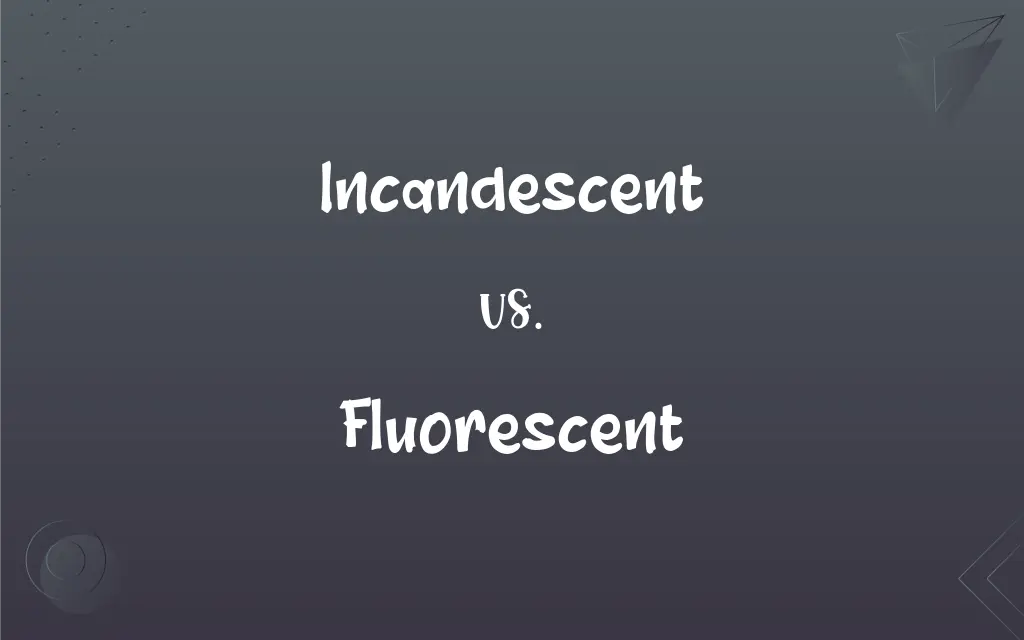Incandescent vs. Fluorescent: What's the Difference?
Edited by Janet White || By Harlon Moss || Updated on October 14, 2023
Incandescent lights produce light through heating a filament, while fluorescent lights emit light via a phosphorescent coating and UV light.

Key Differences
Incandescent bulbs work by passing electricity through a thin wire filament, causing it to heat up and glow, thus emitting light. In contrast, fluorescent lights contain a low-pressure mercury vapor that produces ultraviolet light, which then causes a phosphorescent coating inside the bulb to glow.
When it comes to energy efficiency, incandescent bulbs tend to be less efficient. A significant portion of their energy is wasted as heat. On the other hand, fluorescent lights are more energy-efficient as they convert a higher ratio of energy into visible light, producing less waste heat.
The lifespan of incandescent bulbs is generally shorter compared to their fluorescent counterparts. While an incandescent bulb may last around 1,000 hours, a fluorescent bulb can last up to 10,000 hours or more.
Incandescent bulbs produce a warm, continuous light that can be dimmed easily. Conversely, fluorescent lights may have a cooler tone, can sometimes flicker, and not all are compatible with dimming switches.
In terms of environmental impact, fluorescent bulbs contain a small amount of mercury, making their disposal more of a concern than incandescent bulbs. However, the increased energy efficiency of fluorescent lights can lead to a reduced carbon footprint over their operational lifespan.
ADVERTISEMENT
Comparison Chart
Light Production
Heats a filament to produce light.
Uses UV light and phosphorescent coating to produce light.
Energy Efficiency
Less efficient, more energy wasted as heat.
More efficient, less energy wasted.
Lifespan
Typically around 1,000 hours.
Can last up to 10,000 hours or more.
Light Quality
Warm, continuous, dimmable.
Can be cooler, may flicker, not all are dimmable.
Environmental Concerns
More energy consumption.
Contains mercury but offers better energy efficiency.
ADVERTISEMENT
Incandescent and Fluorescent Definitions
Incandescent
Producing light by heating a filament.
The incandescent bulb glowed warmly in the room.
Fluorescent
Emitting light via a phosphorescent coating and ultraviolet light.
The fluorescent tube lit up the office brightly.
Incandescent
A type of lighting technology that is less energy efficient.
Many people have replaced incandescent bulbs with LEDs to save on electricity.
Fluorescent
Having the ability to glow under ultraviolet light.
The poster had fluorescent colors that glowed under the blacklight.
Incandescent
Emitting light as a result of being heated.
The metal became incandescent after being in the furnace.
Fluorescent
A lighting technology known for its energy efficiency.
Fluorescent bulbs helped reduce the building's energy bill.
Incandescent
Giving off a warm and cozy light.
The incandescent lamp created a cozy atmosphere.
Fluorescent
Using a gaseous discharge to produce ultraviolet light.
The science lab was illuminated by fluorescent lights.
Incandescent
Having a filament that glows to produce light.
She preferred the look of incandescent lighting for her reading nook.
Fluorescent
Containing a phosphor that emits visible light when excited.
The fluorescent paint glowed eerily in the dark room.
Incandescent
Emitting visible light as a result of being heated.
Fluorescent
Of or relating to fluorescence.
Incandescent
Shining brilliantly; very bright.
Fluorescent
Exhibiting or produced by fluorescence
Fluorescent corals.
Fluorescent light.
FAQs
Are incandescent bulbs energy efficient?
Incandescent bulbs are less energy efficient compared to many modern alternatives.
How do incandescent bulbs produce light?
Incandescent bulbs light up by heating a filament.
What makes fluorescent lights glow?
Fluorescent lights use ultraviolet light to excite a phosphorescent coating.
Why are fluorescent lights considered more eco-friendly?
Fluorescent lights are more energy efficient, reducing electricity consumption.
Can I dim fluorescent lights?
Not all fluorescent lights are dimmable, but some specially designed ones are.
Why do incandescent bulbs get hot?
Incandescent bulbs waste much of their energy as heat due to the heated filament.
Can incandescent bulbs be recycled?
Incandescent bulbs aren't typically recycled like fluorescent bulbs but can be disposed of in regular trash.
Are incandescent bulbs banned in the U.S.?
Certain inefficient incandescent bulbs have been phased out, but not an outright ban.
Can I replace an incandescent bulb with a fluorescent one directly?
Yes, provided they have compatible bases and fixtures.
Which light is better for reading, incandescent or fluorescent?
Personal preference varies, but many prefer the warm light of incandescent for reading.
Which bulb lasts longer, incandescent or fluorescent?
Fluorescent bulbs generally have a longer lifespan than incandescent bulbs.
How should I dispose of broken fluorescent bulbs?
Due to mercury, broken fluorescent bulbs should be cleaned up carefully and recycled properly.
Are there different types of fluorescent lights?
Yes, including compact fluorescent lamps (CFLs) and linear fluorescent tubes.
Do incandescent bulbs emit UV light?
Incandescent bulbs emit very little UV light compared to fluorescent.
Can incandescent bulbs affect room temperature?
Yes, incandescent bulbs can raise room temperature due to the heat they emit.
Is it true fluorescent lights contain mercury?
Yes, fluorescent lights contain a small amount of mercury.
Why do some fluorescent lights flicker?
Flickering can be due to various reasons, including aging bulbs, bad ballasts, or electrical issues.
Is the light quality the same between incandescent and fluorescent bulbs?
No, incandescent bulbs emit a warmer light, while fluorescent can be cooler and may vary in tone.
What's the main component inside a fluorescent bulb?
A low-pressure mercury vapor that emits UV light.
Why do fluorescent lights sometimes make a humming sound?
The humming can be from the ballast, which regulates current to the bulb.
About Author
Written by
Harlon MossHarlon is a seasoned quality moderator and accomplished content writer for Difference Wiki. An alumnus of the prestigious University of California, he earned his degree in Computer Science. Leveraging his academic background, Harlon brings a meticulous and informed perspective to his work, ensuring content accuracy and excellence.
Edited by
Janet WhiteJanet White has been an esteemed writer and blogger for Difference Wiki. Holding a Master's degree in Science and Medical Journalism from the prestigious Boston University, she has consistently demonstrated her expertise and passion for her field. When she's not immersed in her work, Janet relishes her time exercising, delving into a good book, and cherishing moments with friends and family.































































